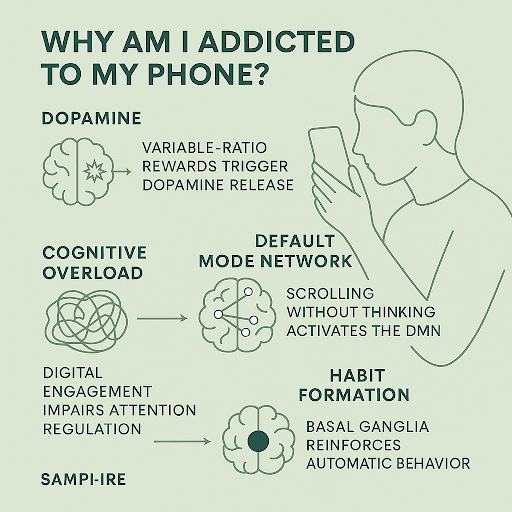
Neuroscience
•
2025-08-18
Why am I addicted to my phone? Neuroscience explains
By Lily Winter, guest contributor in collaboration with Dr. Emilė Radytė, CEO of Samphire Neuroscience
You intend to check one notification; just a moment! 45 minutes later, you’re still scrolling. This is not simply a lapse in willpower. Multiple systems in the brain, shaped by evolution to maximize survival, are being engaged by digital platforms in ways that make disengagement difficult and you - stuck in a loop, with brain science at its core.
How social media uses dopamine against you
When you scroll and encounter something novel, surprising, or emotionally charged, your brain releases dopamine: a neuromodulator involved in motivation, learning, and reinforcement. This explains why most “addictive” content on your pages is novel and surprising (some form of movement or weird behaviour), or emotional (cute kittens and puppies).
Social media feeds and endless-scroll interfaces use a variable-ratio reinforcement schedule, where rewards are delivered unpredictably. For example, you don’t know how many videos you need to scroll through until you find a video you love: sometimes, it might be that every video is perfectly engaging, other times you’re scrolling through hundreds of videos before one catches your eye (and attention). This unpredictability means your brain forces you to keep going (scrolling!) to get the reward (a cute puppy!).
This pattern, also used in slot machines, is one of the most effective ways to strengthen a behaviour because the brain learns to persist in the action in anticipation of the next reward.

The Default Mode Network and passive scrolling
When scrolling becomes habitual and requires little conscious engagement, the Default Mode Network (DMN) often becomes more active (read more about brain networks here!). The DMN is a large-scale brain network involved in self-referential thought, mental time travel, and mind-wandering.
In this low-effort, relaxed state, it’s easier to lose track of time. Reduced engagement of top-down control can allow the behavior to continue with minimal conscious regulation. So, you’re scrolling, but your brain’s conscious control systems are largely offline - your more primitive ‘lizard brain,’ built for instinct and habit, is in charge!
How habits form in the brain and the basal ganglia
Over time, repeated scrolling activates the basal ganglia, a set of structures deep in the brain responsible for habit formation. Initially, phone checking is a goal-directed behaviour: your brain wants to see a cute puppy image. With repetition, control shifts toward stimulus-response loops, which operate with less conscious oversight.
This shift is why scrolling can feel “automatic”: the brain has optimized it as a default action in response to cues (e.g., boredom, a notification, or simply seeing the phone).
Why scrolling feels relaxing, but leaves you drained
A Nature study by Lindstrom and colleagues in 2021 found that constant exposure to rapid, high-volume information streams increases cognitive load and decreases the efficiency of attentional control networks. When cognitive resources are depleted, the prefrontal cortex’s ability to inhibit ongoing, low-value behaviours weakens.
This helps explain why it is harder to stop scrolling after prolonged exposure: the very systems required to regulate behaviour are already fatigued by the stream of incoming stimuli.This also explains why you may feel “relaxed” when scrolling social media, but feel exhausted once you stop.
Can you break the scrolling habit?
Recognizing how these neuroscientific mechanisms operate makes it possible for you to intervene.
Practical steps include:
- Noticing mode shifts: are you purposefully seeking information (attention networks are active in the brain), or are you drifting passively (DMN-dominant behaviours)?
- Breaking reinforcement chains: interrupt scrolling sessions before unpredictable rewards can occur (“missing out” on the opportunity to find good content);
- Reducing cognitive fatigue: limiting total exposure time preserves the executive control required to self-regulate, and allows you to stay in control.
The Samphire Connection
At Samphire Neuroscience, our approach is always brain-first. Samphire - our cycle tracking app -helps you observe patterns in your behavior, mood, and attention, including how digital habits fluctuate with your hormonal cycle.
For individuals who struggle with cycle-linked lapses in cognitive control, Nettle™ supports the prefrontal circuits that regulate large-scale brain networks. By enhancing top-down control, Nettle™ can help reduce automatic, cue-driven behaviours, whether they involve doomscrolling or other unhelpful habits, without disrupting healthy neurochemical rhythms.
References
- Lindström, B., Bellander, M., Schultner, D.T. et al. A computational reward learning account of social media engagement. Nat Commun 12, 1311 (2021).
- James, R. J. E., O’Malley, C., & Tunney, R. J. (2016). Why are some games more addictive than others: The effects of timing and payoff on perseverance in a slot machine game. Frontiers in Psychology, 7, 46.
- Guidi, B., Clemente, V., García, T., & Ricci, L. (2020, September 14). A rewarding model for the next generation social media. In GoodTechs ’20: Proceedings of the 6th EAI International Conference on Smart Objects and Technologies for Social Good (pp. 169–174). Association for Computing Machinery.
- Fareri, D. S., & Delgado, M. R. (2014). Social rewards and social networks in the human brain. The Neuroscientist, 20(4), 387–402.
- Fayzhia, S. I., & Setiawati, Y. (2024). The interplay of ADHD, social media usage, and dopamine receptors in adolescents: A literature review. World Journal of Advanced Research and Reviews, 23(2), 2698–2703.

